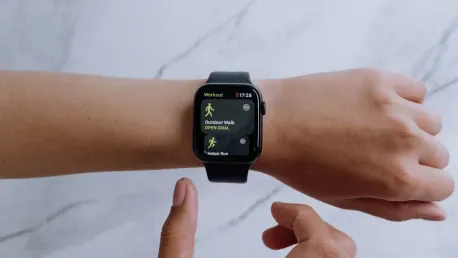Wearable technology has become an integral part of modern healthcare, offering innovative solutions for personal health management. These devices, ranging from fitness trackers to advanced medical monitors, are transforming how individuals monitor and manage their health. This article explores the various ways wearable technology is revolutionizing personal health management, highlighting key advancements and applications.
Introduction to Wearable Technology in Healthcare
Wearable technology encompasses a wide range of electronic devices designed to be worn on the body. These devices have evolved significantly over the past decade, transitioning from simple pedometers to sophisticated health management tools. The integration of wearable technology within healthcare systems is enhancing its utility, presenting new opportunities in preventive medicine, chronic disease management, and overall health improvement.
Evolution of Wearable Devices
Wearable technology has come a long way from its early days. Initially, devices like pedometers were used to count steps and track basic physical activity. Today, wearables include fitness trackers, smartwatches, and specialized medical monitors that offer a plethora of health metrics. These advancements have made wearables indispensable tools for personal health management.
These enhancements are profoundly impacting how individuals track their health, with wearables now measuring heart rate, sleep patterns, blood oxygen levels, and more. Leveraging sophisticated sensors and data analytics, these devices provide insights that were once only accessible in clinical environments. For example, continuous glucose monitors have revolutionized diabetes management, offering real-time updates and alerts to users, thus enabling better control over their condition.
Importance of Wearable Technology
The significance of wearable technology lies in its ability to empower individuals to take control of their health. Continuous monitoring of various health parameters enables users to make informed lifestyle choices. Additionally, these devices facilitate communication between patients and healthcare providers, supporting comprehensive health oversight. Continuous data collection through wearables promotes self-management of health conditions, making them essential in contemporary health practices.
Regular monitoring and data collection can significantly help in recognizing early signs of illness, leading to prompt medical intervention. These benefits extend to managing chronic diseases where timely insights can make a massive difference in treatment outcomes. Moreover, by integrating health metrics with mobile apps, users can receive immediate feedback and recommendations, creating a more interactive and engaging health management process. Such integration helps bridge gaps in traditional healthcare delivery, particularly in remote areas.
Technological Advancements in Wearables
The wearable technology sector has witnessed rapid advancements, particularly in areas like sensor technology, battery life, connectivity, and data analytics. These developments have significantly improved the accuracy and efficiency of wearable devices in health metric monitoring.
Advanced Sensor Technology
Recent advancements in sensor technology have enabled wearables to monitor various health metrics, including EKG readings, heart rate variability, blood pressure, glucose levels, and sleep patterns. These sensors have become more compact and precise, allowing for key health metric monitoring without traditional medical equipment.
These advanced sensors often use photoplethysmography (PPG) and electrodermal activity (EDA) to acquire accurate readings of physiological parameters. The integration of these sensors into compact wearables allows continuous, non-invasive monitoring, which is crucial for chronic conditions and preventive healthcare. The precision offered by these technologies is helping individuals gain a clearer understanding of their health status in real time, making wearable devices indispensable in detecting anomalies early and seeking timely medical advice.
Improved Battery Life
Improvements in battery life are crucial for the sustained use of wearable devices. Enhanced battery technologies and energy-efficient components have resulted in devices that can last several days or even weeks on a single charge. This reduces interruptions in data collection, facilitating seamless health monitoring.
Longer battery life directly enhances the user experience by minimizing the need for frequent recharging, which can disrupt continuous health monitoring. Energy-efficient chipset designs and advanced power management features are pivotal in achieving extended battery performance. Consequently, users can rely on their devices for longer periods, ensuring consistent data collection and uninterrupted health insights. This is particularly beneficial for elderly users or those managing chronic conditions who require ongoing health data monitoring.
Data Analytics and AI Integration
The rise of data analytics and AI integration is revolutionizing how wearables deliver health insights. AI algorithms can analyze large data sets, providing users with predictive health insights and personalized feedback tailored to their unique health profiles. This proactive approach allows for early detection of potential health issues, enabling users to take preventive measures promptly.
Machine learning models analyzing wearable data are capable of identifying patterns and trends that may not be evident to the user. For example, AI can predict the likelihood of cardiac events by analyzing heart rate variability and other metrics over time. Personalized health feedback driven by AI empowers users with actionable insights, guiding them to make health-conscious decisions. This advanced analytical capability is elevating wearable technology from simple data collection tools to robust health management systems, offering personalized and precise health intervention strategies.
Applications of Wearable Technology in Personal Health Management
Wearable technology has numerous applications in personal health management, from fitness tracking to chronic disease monitoring. These devices offer valuable insights and support for various health aspects.
Fitness Tracking
One of the most prominent applications of wearable technology is fitness tracking. Devices like Fitbit and Apple Watch offer built-in fitness tracking functionalities that encourage users to stay active by setting and achieving fitness goals. Many devices feature competitive challenges, fostering community engagement and motivation for physical activity.
Fitness trackers provide users with comprehensive data about their physical activities, such as steps taken, calories burned, and distance covered. The real-time feedback and personalized activity recommendations help individuals tailor their exercise routines to meet their fitness objectives. The integration of GPS technology even allows for accurate tracking of outdoor activities like running and cycling. Features such as heart rate monitoring during exercise provide deeper insights into cardiovascular health, making fitness trackers valuable tools for overall wellness.
Chronic Disease Management
Wearable technology has proven highly beneficial for managing chronic diseases such as diabetes. Continuous glucose monitors (CGMs) enable individuals to track blood glucose levels in real time, providing alerts when levels become too high or too low. This immediacy helps users make timely decisions regarding their diet, exercise, and medication, leading to better health outcomes.
In addition to diabetes management, wearables are used for monitoring heart conditions, asthma, and even chronic pain. Devices capable of tracking electrocardiograms (EKGs) and other vital signs allow for regular monitoring without the need for frequent hospital visits. This data can be shared with healthcare providers to tailor treatments more effectively. The continuous flow of information from wearables aids in precise medication timing, dietary adjustments, and lifestyle changes, significantly improving disease management and quality of life for users.
Mental Health Monitoring
Wearables are increasingly used in mental health monitoring, offering tools for stress relief and mindfulness. Some devices include guided breathing exercises or meditation apps to help users manage anxiety and improve overall mental well-being. By tracking physiological indicators of stress through biometric sensing, these devices encourage the adoption of healthy coping mechanisms.
Biometric sensors can detect subtle changes in metrics such as heart rate variability, skin conductance, and blood oxygen levels, which are indicative of stress and emotional states. By analyzing this data, wearables can provide insights into stress levels and recommend relaxation techniques. Features like mood tracking and sleep analysis contribute significantly to understanding mental health patterns. Such comprehensive insights enable users to adopt proactive mental well-being strategies, making wearables essential tools in the realm of mental health management.
Enhancing User Experience and Engagement
The success of wearable technology in personal health management largely depends on user experience and engagement. Manufacturers are continuously working to improve these aspects to ensure that users derive maximum benefit from their devices.
User-Friendly Interfaces
Wearable devices are designed with user-friendly interfaces to make health monitoring accessible to everyone. Simple and intuitive designs ensure that users can easily navigate through various features and understand their health metrics without any hassle.
Clear display screens, straightforward navigation buttons, and user-friendly mobile apps are key to enhancing the usability of wearable devices. These features ensure that users, regardless of technical proficiency, can effectively utilize their devices to track their health. By offering easy access to collected data and comprehensible health insights, wearables become more engaging and useful. This seamless user experience is crucial for sustained use and maximizing the health benefits derived from wearable technologies.
Gamification and Social Features
Many wearable devices incorporate gamification and social features to enhance user engagement. By turning health monitoring into a game, users are more likely to stay motivated and committed to their health goals. Social features, such as sharing achievements and participating in challenges, foster a sense of community and support.
Gamification strategies include setting fitness goals, earning badges, and participating in virtual competitions with friends or global users. These creative elements inject a fun and competitive spirit into routine health activities, making them more enjoyable. Social integration allows users to share their progress on platforms, receive encouragement, and build motivational networks. Such social connectivity and interactive features drive higher user engagement rates, ensuring that individuals remain consistent with their health routines.
Personalized Feedback and Recommendations
Wearable technology leverages data analytics to provide personalized feedback and recommendations. By analyzing individual health data, these devices offer tailored advice on diet, exercise, and lifestyle changes, helping users make informed decisions to improve their health.
Advanced algorithms consider various health metrics to generate customized health plans and objectives. For instance, wearables can recommend specific exercise routines based on fitness levels or dietary adjustments in response to glucose monitor readings. Personalized notifications about medication schedules, hydration reminders, and sleep hygiene tips further enrich the user experience. This bespoke approach ensures that health recommendations are relevant and actionable, enabling users to achieve better health outcomes more effectively.
Addressing Privacy and Security Concerns
While wearable technology offers numerous benefits, it also raises concerns about privacy and security. Ensuring the protection of sensitive health data is crucial for the widespread adoption of these devices.
Data Security Measures
Manufacturers are implementing robust security measures to protect user data. Encryption technologies, secure data storage solutions, and stringent authentication processes are employed to safeguard personal health information. Regular security updates and compliance with health privacy regulations, such as HIPAA, are critical steps in maintaining data integrity and user trust.
Users should also be proactive in securing their devices by using strong passwords, keeping software updated, and being cautious about the apps they authorize to access their data. By adopting these measures, individuals can minimize the risks associated with wearable technology. The collaboration between manufacturers and users in prioritizing data security ensures a safer environment for health data management, ultimately fostering greater confidence in the use of wearable technologies.
User Awareness and Consent
Wearable technology has become a crucial component of modern healthcare, offering cutting-edge solutions for personal health management. These devices, which include everything from fitness trackers to sophisticated medical monitors, are changing the way individuals keep track of their health. By providing real-time data on various health metrics, wearables enable users to take charge of their health more effectively than ever before. This article delves into the different ways wearable technology is transforming personal health management. It highlights significant advancements such as continuous glucose monitors for diabetes management, smartwatches that track heart rate and detect irregularities, and wearable ECG monitors that alert users to potential heart issues. Moreover, these devices have applications extending beyond individual use, as they can sync with healthcare providers’ systems, offering a more integrated approach to patient care. Such innovations ensure better outcomes and improved quality of life, signifying a substantial leap forward in personal health management.









